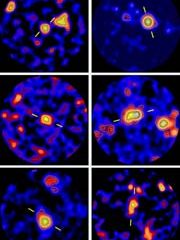This area deals with the fundamental laws and building blocks of nature and how they interact, the properties and the behavior of matter, and research into space and time and their structures.
innovations-report provides in-depth reports and articles on subjects such as astrophysics, laser technologies, nuclear, quantum, particle and solid-state physics, nanotechnologies, planetary research and findings (Mars, Venus) and developments related to the Hubble Telescope.

SMART-1’’s revolutionary propulsion system was successfully fired at 12:25 UT on 30 September, 2003, in orbit around the Earth.
Engineers at ESOC, the European Space Agency’’s control centre in Darmstadt, Germany, sent a command to begin the firing test, which lasted for one hour. This was similar to a trial performed on Earth before SMART-1 was launched.
Several months ago, the ion engine, or Solar Electric Primary Propulsion (SEPP) system, had been placed in a vacuu

Astronomers have discovered two of the smallest moons yet found around Uranus. The new moons, uncovered by NASA’s Hubble Space Telescope, are about 8 to 10 miles across (12 to 16 km) — about the size of San Francisco.
The two moons are so faint they eluded detection by the Voyager 2 spacecraft, which discovered 10 small satellites when it flew by the gas giant planet in 1986. The newly detected moons are orbiting even closer to the planet than the five major Uranian satellites, which

The world’s particle physics community today announced the launch of the first phase of the LHC computing Grid (LCG). The LCG is designed to handle the unprecedented quantities of data that will be produced by experiments at CERN ’s Large Hadron Collider (LHC) from 2007 onwards. “The LCG will provide a vital test-bed for the new Grid computing technologies that are set to revolutionise the way scientists use the world’’s computing resources in areas ranging from fundamental research to

Elusive brown dwarfs, the missing link between gas giant planets like Jupiter and small, low-mass stars, have now been “fingerprinted” by UCLA astronomy professor Ian S. McLean and colleagues, using the Keck II Telescope at the W.M. Keck Observatory in Hawaii.
McLean and his research team will publish the most systematic and comprehensive near-infrared spectral analysis of more than 50 brown dwarfs in the Oct. 10 issue of the Astrophysical Journal, the premier journal in astronomy, publi

Revealing images produced by one of the world’s most sophisticated telescopes are enabling a team of Edinburgh astronomers to see clearly for the first time how distant galaxies were formed 12 billion years ago. Scientists from the UK Astronomy Technology Centre (UK ATC) and the University of Edinburgh have been targeting the biggest and most distant galaxies in the Universe with the world’s most sensitive submillimetre camera, SCUBA. The camera, built in Edinburgh, is operated on the James Clerk Ma

A Lawrence Livermore National Laboratory astrophysicist, in collaboration with international researchers, has found evidence for the synchronous formation of massive, luminous elliptical galaxies in young galaxy clusters.
The forming galaxies were detected at sub-millimeter wavelengths. Emission at these wavelengths is due to dust from young stars that is heated by the stars or by active black holes. The galaxies were grouped around high-red shift radio galaxies, the most massive systems kn